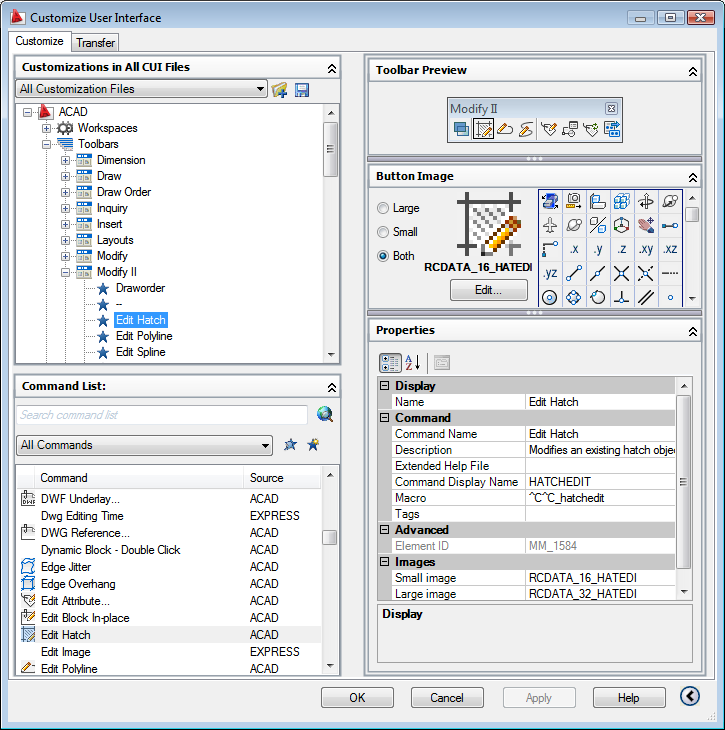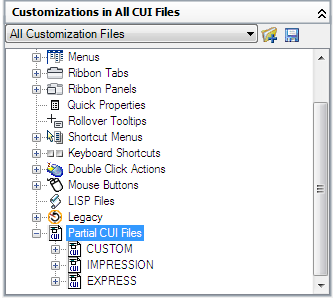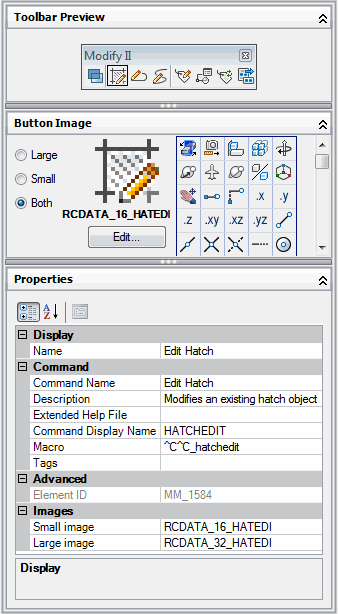
|
|

|

|
|

|
The Customize User Interface (CUI) Editor is used to modify customization that is in the XML-based CUI file.
The Customize User Interface (CUI) Editor is used to modify customization that is in the XML-based CUI file. The editor allows you to create and manage commands that are used in the CUI file in a centralized location. Along with commands, you are able to customize many of the different user interface elements. From the CUI Editor you can customize
- Double click actions
- Legacy user interface elements (tablets, tablet buttons, screen menus and image tile menus)
- Mouse buttons
- Pull-down menus
- Quick Access toolbar
- Quick properties
- Toolbars
- Ribbon panels
- Ribbon tabs
- Rollover tooltips
- Shortcut keys
- Shortcut menus
- Temporary override keys
- Workspaces
Before you start customizing your own menus,
toolbars, and other user interface elements, you should familiarize
yourself with the customization environment. To open the Customize
User Interface Editor, click Tools tab  Customization
panel
Customization
panel  User
Interface.To open the Customize
User Interface Editor, enter cui at the Command
prompt. Once the Customize User Interface
(CUI) Editor is opened, view the contents of the loaded customization
files by expanding the elements in the tree structure, and view
the properties of the elements by selecting them.
User
Interface.To open the Customize
User Interface Editor, enter cui at the Command
prompt. Once the Customize User Interface
(CUI) Editor is opened, view the contents of the loaded customization
files by expanding the elements in the tree structure, and view
the properties of the elements by selecting them.
Select the Transfer tab to see how to migrate or transfer customizations; select the Customize tab to see how to create or modify user interface elements.
Once you are familiar with the environment, you can start to take advantage of the capabilities of the tools. For more information about the improved customization capabilities, see How Customization Has Changed.
Following is an example of the Customize User Interface (CUI) Editor, Customize tab. You use this tab to customize interface elements in CUI files.

Customize the user interface to make the drawing environment specific to certain types of tasks. For example, if you want a toolbar that contains the commands you use most often, you can create a new Favorites toolbar in the Customize User Interface (CUI) Editor and then load the new toolbar in AutoCAD.
The Customizations In pane is used to navigate the different user interface elements that are in the loaded customization files. In this pane, you create and modify user interface elements such as workspaces, toolbars, and menus. Along the top of the pane you will find tools that load partial customization files into the main customization file, save changes to the loaded customization files, and control how you view the loaded customization files.
The tree view is used to create new user interface elements such as toolbars and menus. Once a new user interface element is created, commands can then be added by dragging them from the Command List pane. Along with being able to create user interface elements and add commands to a user interface element, you can change the order in which commands appear on toolbars, menus, and ribbon panels by dragging them up and down.

The Command List pane is used to create and locate commands that are contained in the loaded customization files. Use the Create a New Command button to create a new custom command in the CUI file that is listed in the Customization File drop-down list at the top of the Customizations In <file name> pane. A command must be created before it can be associated with a user interface element in the Customizations In <file name> pane.
Next to the Create a New Command button is the Find Command or Text button. The Find Command or Text button displays the Find and Replace dialog box, where you can search for or replace text strings in the Command List pane only.
The Categories drop-down list near the top of the Command List pane contains a listing of preset categories used to filter the commands displayed in the Command list box. There are many different categories that you can select from, for example
- All Commands. Displays all of the commands for each of the loaded customization files.
- Custom Commands. Displays the user defined commands that have been added to the loaded customization files. These commands are not part of a customization file that ships with AutoCAD.
- Controls Elements. Displays the special controls that can be added to a toolbar or ribbon panel, such as drop-down lists, sliders, and other controls.
Available commands and controls are displayed in the bottom of the Command List pane. The names of the available commands, the image that is assigned to a command, and the name of the customization group that the command is assigned to are displayed. When the cursor hovers over top of a command, the macro assigned to the command is displayed in a tooltip.
At the top of the Command List pane is the Command Filter field which allows you to filter the Command list based on the text string entered. The text string is matched with any part of a command name, and the commands with the matching text strings are displayed in the Command list box.
The Dynamic Display pane controls the display of additional panes that respond to the item that is selected in either the Customizations In pane or Command List pane. Based on the item selected, one or more of the following panes will be displayed:
- Button Image
- Information
- Panel Preview
- Properties
- Quick Properties
- Shortcuts
- Toolbar Preview
- Workspace Contents



